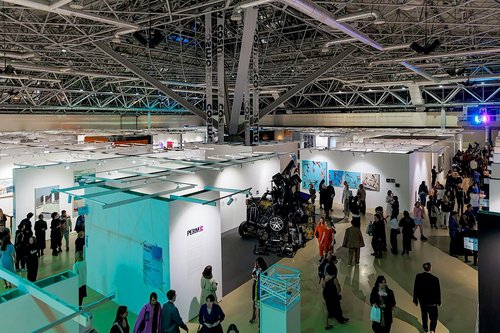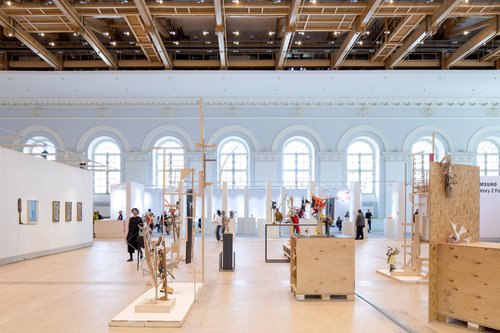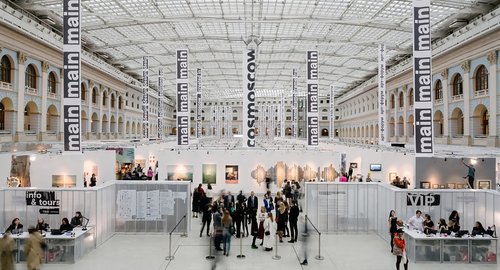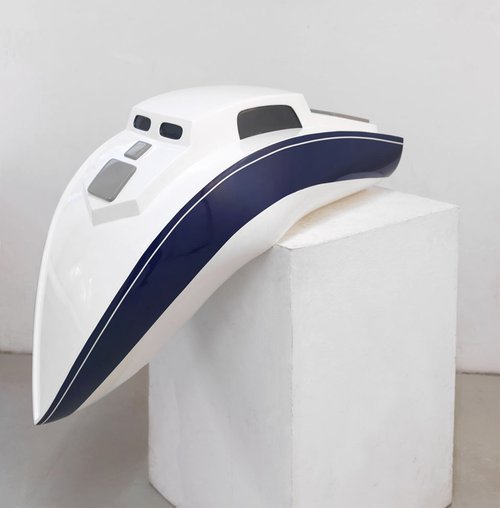Arts, Crafts and Censors at blazar Fair

blazar art fair. Moscow, 2024. Courtesy of blazar art fair
blazar art fair for young artists under the age of 35 has become a new stand-alone event in Moscow’s ever more crowded art events calendar. Attracting queues of enthusiastic visitors despite censorship issues, it reveals a preference among emerging artists for the arts and crafts.
blazar (whose organizers seem to have a strange aversion to capital letters) started as a satellite to Cosmoscow, Russia’s biggest contemporary art fair. Unlike its older sibling who has followed a traditional art fair model with gallery booths, blazar offers modestly priced works by young artists who have no gallery representation. Artists apply for free booth space via an open call and are selected by an expert board. Both fairs used to run hand in hand, but this year, Cosmoscow’s dates have shifted from September to late October, whereas blazar has remained in the same slot in September and the same location - the Museum of Moscow, a municipal institution which often rents its halls out for cultural events (at one time even housing a temporary military conscription office, when mobilization was announced in Russia in 2022).
However, this year blazar has gravitated towards a more traditional art fair model. Gallery booths occupy over half the space, many sponsored by the Moscow city government who in recent years has paid for floor space at some of the city’s major fairs and giving it to Moscow galleries free of charge to support local, small businesses. Artists with no representation are accommodated in an open central space, not divided into booths. During the preview, some looked lost, pacing back and forth in front of their own creations lined along the walls and striking up conversations with prospective buyers, with nowhere to even sit down. There is also a separate dark room for digital art in the back of the main hall and another section for collectable design on another floor. There was a packed, clammy atmosphere on preview day, the historical warehouses of the Museum of Moscow are notorious for their insufficient ventilation and fans and portable AC units brought in for the occasion did not help much.
These days to use a state-run museum in Russia as a venue brings with it another major drawback: censorship. On the morning of the preview day, bas-reliefs, and drawings by Artgroup17 depicting female nudes were removed from the wall and Telegram art blog coo-coo (Courier of Culture) reported that an installation by art collective Malyshky 18:22 was also taken away. blazer’s press office did not respond to Art Focus Now’s request for comments about these two incidents.
The low prices attract young and emerging collectors with prices starting at a modest 5,000 roubles (about 50 Euros) and rarely exceeding 200,000 roubles (2,000 Euros). Artworks with price tags of 1,000,000 roubles (10,000 Euros) are few and far between. Red dots started appearing en masse during the first hours of the preview, and the staff in the packing room at the entrance of the fair were working non-stop.
The artists in this new generation are strong on handicrafts, such as ceramics and embroidery with almost every booth at the fair featuring works in textile, ceramics, or metal. It is not uncommon now for artists to experiment with a variety of different craft media. Artyom Lyapin (b. 1996) who comes from the outskirts of Irkutsk in Siberia and was trained as an architect, used to experiment with lacemaking, yet has recently started to work with metal. Moscow’s Flor et Lavr gallery exhibited his semi-abstract collages combining pieces of tin and wattled tin wire placed on steel plates. These works from a new series ‘The House That Ate Itself’ were priced at 150,000 roubles (1,500 Euros) each. Nathalie-Kate Pangilian (b. 1993), a well-known theatre artist and illustrator, has collaborated with Fedoskino, the famous lacquer-painting manufacture near Moscow which dates back to the 18th century. Her wall was covered with seashells adorned with lacquered photographs of male and female nudes curled up like embryos, friends and acquaintances who volunteered to pose for her project ‘Far Eastern Venus’. Somehow this showcase of the beauty and fragility of the human body did not alarm the censors. The artist offered each shell at 15,000 roubles (150 Euros). One special booth dedicated to the ‘Region of the Year’ featuring artists from Tatarstan, teems with small textile and ceramic pieces that give it the air of a souvenir shop. Colourful embroidered cut-out silhouettes by Zukhra Salakhova (b. 1997), priced from 5,000 to 25,000 roubles (50-250 Euros) were sold out during the first few hours of the fair. With a strong trend for cute and portable hand-crafted artwork, it is no surprise that the fair’s new Design section stretches over the entire spacious hall on a separate floor featuring quirky, barely functional furniture, decorative objects and, inevitably, a lot of ceramics.
In this curio shop atmosphere, the digital art section, unexpectedly, is a breath of fresh air. The virtual world is the milieu where young artists from the generation of digital natives are most at ease and while their handicrafts often turn out to be clumsy and derivative, their digital artworks are masterful and mature. The one and only copy of a meditative, black-and-white video by Anastassia Anosova (b. 2005) ‘Flecks, Shadows, Penumbra’ showing a series of twenty-five semi-abstract photographic images whose serene surface is rippled by digital waves, accompanied with lines of poetry is offered for a mere 20,000 roubles (200 Euros). While Anosova’s work had an inner relation to the medium of works on paper, two other artists produced compelling works with a painterly approach to digital art. Lidia Kovalevich’s mesmerizing, shifting and blurred images of flowers go at 80,000–120,000 roubles (800–1200 Euros) for a 2-to-3-minute video, each coming in an edition of three. In a video by Darina Dash figures of brightly clad people evolve into a geometric abstraction, an eye-catching one-off piece priced at 125,000 roubles (1250 Euros).
Among the highlights of the fair are inventive hi-tech creations by St. Petersburg artist Dariella (b. 1999) who uses an unusual technology of video projection on holographic ventilators. This medium creates a hypnotic effect of vibrating, breathing forms unattainable on a conventional LCD screen. Moscow’s Platforma Forma Gallery offers her works (coming in an edition of five) at 125,000 to 520,000 roubles (1250–5200 Euros). The highest price is charged for an installation made from three ventilators. Too bad they could not produce any real movement of the air – not even in the literal sense.
























